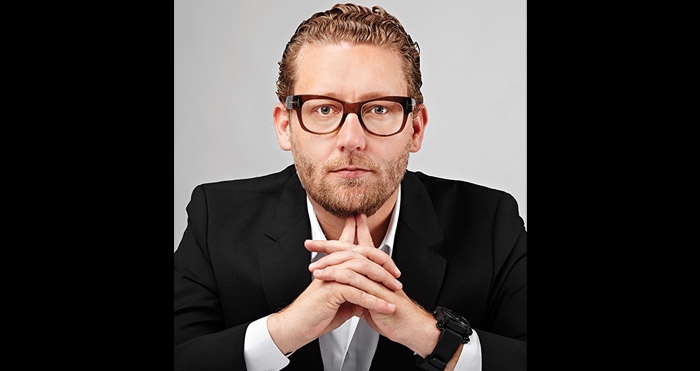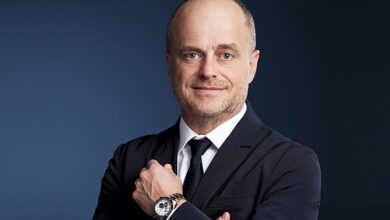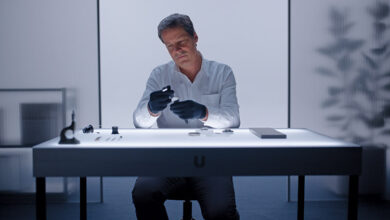Romain Jerome ingenious representations

With its colourful ball-pit, arcade games and freshly popped popcorn, it was easy to imagine being surrounded by the excited chatter of youngsters at the world’s best amusement park, but in reality we were standing at the stunning avant-garde booth of Romain Jerome at Baselworld 2015, that took place earlier this year in March
Day and Night Magazine savoured the playful experience a young brand such as Romain Jerome offered at the most anticipated watch and jewellery fair in the industry. Joining the brand’s CEO, Manuel Emch, for an exclusive chat, one of the things we learnt was that not all of Romain Jerome’s ideas are implemented, but those which manage to gain materials and certifications are worthy of admiration from watch connoisseurs.
Romain Jerome watches aren’t based on any historical philosophy, what inspires customers to purchase from the brand?
The inspiration comes from the aesthetics of the watch or its symbolism. When customers purchase an item, they use their emotions to guide them. What does it make them think of? How does it make them feel? These questions are answered in a positive sense and only then does the customer make the decision to purchase. As the brand doesn’t have a long history to speak of, it relies on watches that have a historical element or a popular theme from modern culture and art, which can be worn on the wrist as a reminder.

Romain Jerome has some pretty unusual timepieces. What has been the most unique timepiece produced under your guidance?
Under my management, every Romain Jerome timepiece boasts a unique tale that holds its own charm. The charm is only revealed to a customer according to what they want to see, or how the exterior of the watch makes them feel. For example, we used the idea of video games to create the Space Invaders and PAC-MAN collection, which may seem fun and quirky to some clients whilst others may not think much of it. Another unique watchmaking method we have used that our clients enjoy is the tattooing art form, where we tattooed the bracelet of a watch – these designs may appeal to the masses or just to a select few. But whatever the tastes, Romain Jerome is sure to have something to cater for a client’s need, whether it is provocative and bold or subtle and modest – we are very distinctive in our niche art form.
What timepiece do you think will receive a lot of attention here, at Baselworld 2015?
There are two timepieces that have already received the most attention; one is the complex Steampunk Tourbillon and the other is the Subcraft. The partially skeletonized Steampunk features a large tourbillon, where the dial has been split into four functional parts. On the top, at 12 o’clock, is the running time with hours and minutes. At the bottom is the impressive tourbillon, and at 9 o’clock is a vertical piston that is connected to the movement, that goes up and down in 60 seconds. Finally, at 3 o’clock, is the power reserve. The mechanical Subcraft, on the other hand is completely different with its titanium case and round display disc on top.
Can you tell us about the Eyjafjallajökull Evo timepiece, that was released in April 2014 and uses Icelandic Volcano rock?
The Volcano timepiece was initially created as a marketing gimmick; it was never meant to be sold. However, the inspiration for the piece came from the actual event where the Eyjafjallajökull (Icelandic for “Island mountain glacierâ€) volcano erupted back in 2010. The resulting smoke had a rippling effect that caused massive delays to transportation, especially aeroplanes and for this reason Romain Jerome decided to dedicate the hour and minutes hands to those delays, by shaping the ends like little planes. The timepiece has sold extremely well as customers are keen on the detailing as well as the textured black dial that seems to crack open to allow red hot lava to spill out.
How difficult is it to source material for timepieces? For example – the Eyjafjallajökull Evo uses Icelandic Volcano rock and the Skylab timepiece features Apollo 11 components – so where does the material come from?
Well, it depends on what we require. Sometimes it’s easy as attending an auction and other times it’s very hard where we have to fill in a lot of paperwork. With the Volcano watch, we initially created it as a virtual piece for marketing purposes, and the design caught the eye of the Icelandic Volcanic Institute, who loved the concept and asked us to create a real model and in return offered to supply us with the materials. So we agreed, and the result was a stunning masterpiece that uses real Icelandic rock.
With the Skylab timepiece, we had to invest around a million dollars at auctions to secure Apollo 11 materials which we could melt and re-use. Needless to say it was one of our most expensive investments.  Our Titanic timepiece was a little more difficult to produce as we had to contact the ship’s builders, Harland and Wolff, to source the required steel needed to produce our products. They also put us in touch with deep-sea explorers who salvaged parts of the sunken vessel and we had to negotiate with them for materials, which was a lengthy and expensive process.
Primarily your watches are aimed at men, are there any plans to cater for women at an equal level?
Hopefully in the future I would have figured out what women want. Currently about 10% of our customers are women, and we are looking to increase that figure in the future by making smaller sized cases, using feminine colours and using precious gems, but for now I have no idea how to incorporate the DNA of the brand into a feminine timepiece and until inspiration hits, it will probably remain that way.





